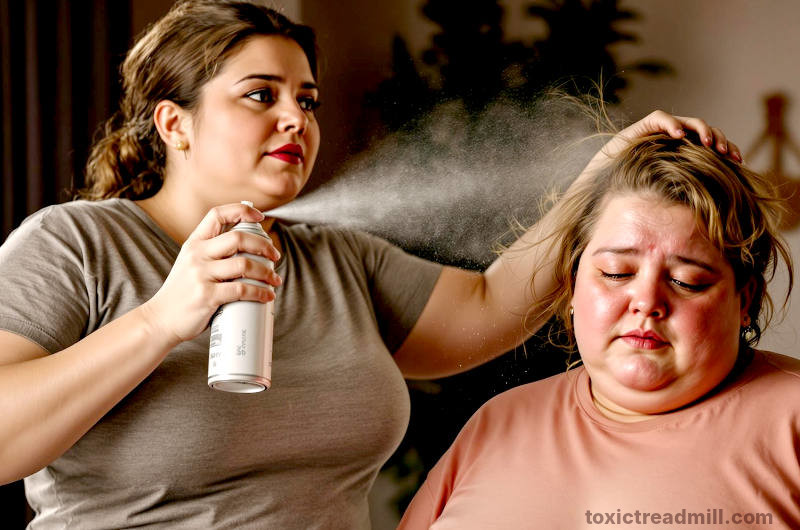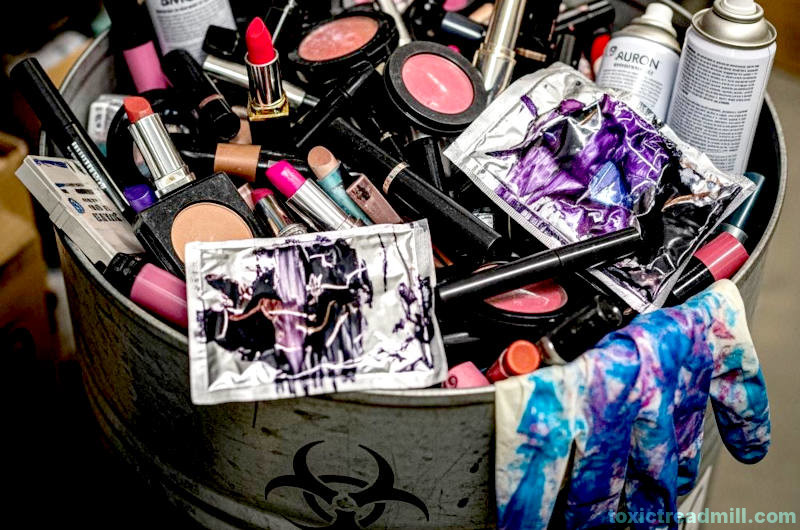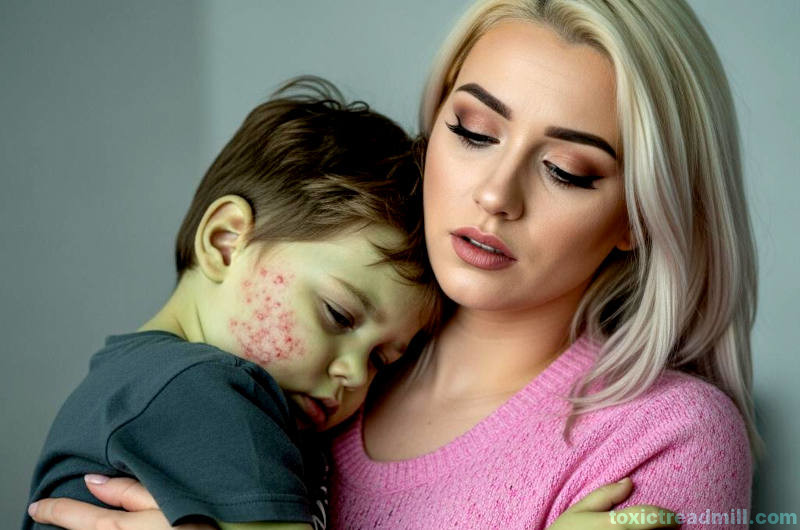Toxic Treadmill
Evidence for a Poisoned Planet
Health Harms Caused by Makeup and Hairstyling Products
Cosmetic products used for hairstyling and make‐up are formulations that typically contain complex chemical mixtures. Research has shown there are at least 12 500 industrial chemicals used in cosmetics. Substantial evidence exists regarding the presence of various toxicants in products such as hair spray, hair relaxants, dyes, and make-up, including ingredients with carcinogenic, endocrine-disrupting, neurotoxic, and bioaccumulative properties. Clinical and epidemiological research as well as toxicological evaluations have documented potential risks associated with both current formulations and historical products no longer permitted yet still persistent in the environment or within human tissues over time. A recurring finding is the link between repeat exposure and chemical sensitization, which causes inflammation, respiratory problems, and skin disease; this link highlights the importance of keeping these chemicals away from children and pregnant women to avoid lifelong chronic disease.

Chemicals of Concern in Cosmetics
Heavy Metals and Inorganic Contaminants
Several studies have highlighted the presence of heavy metals such as lead, mercury, cadmium, arsenic, nickel, cobalt, and chromium in products including lipsticks, mascaras, foundations, eyeliners, nail varnishes, and certain hair dyes. These metals are often introduced either through contamination during manufacturing or from the use of mineral-based pigments and other inorganic ingredients. Heavy metals are widely recognized for their carcinogenic potential, neurotoxicity, endocrine disruption, and immunotoxicity with associated with adverse effects on the eyes, skin, respiratory, reproductive, vascular, and neurological systems. They can interfere with complex biochemical signalling pathways and enzyme functioning, cause sexual dysfunction, anaemia, cardiovascular disease, and add significantly to overall oxidative stress. Furthermore, many of these metals are environmentally persistent and exhibit bioaccumulation, thereby extending their risk beyond direct human exposure to ecological damage in soil and water systems.
Formaldehyde and Formaldehyde-Releasing Agents
Multiple cosmetic products, particularly hair dyes and nail varnishes, have been reported to contain formaldehyde or formaldehyde-releasing chemicals such as Diazolidinyl urea, 1,3-Dimethylol-5,5-dimethylhydantoin, and Quaternium-15. Formaldehyde is classified as a known human carcinogen and has been linked to allergic contact dermatitis, respiratory irritation, and possible systemic toxicity arising from chronic dermal absorption. Despite regulatory limits, concern remains regarding cumulative exposure from cosmetic use and the potential for enhanced skin penetration when used in combination with other dermal chemicals.
Aromatic Amines and Phenylenediamines in Hair Dyes
Compounds such as p-phenylenediamine (PPD) and related aromatic amines are key constituents in hair dyes and have been associated with allergic reactions—including contact dermatitis, angioedema, and severe hypersensitivity responses. In occupational settings, repeated exposure to oxidative hair dye components has been linked not only to skin sensitization but also to airway diseases such as occupational asthma and rhinitis in hairdressers. Epidemiological evidence suggests that chronic exposure to these chemicals may be associated with an increased cancer risk, particularly with long-term, repeated use.
Phthalates and Plasticizers
Phthalates, including diethyl phthalate (DEP), dibutyl phthalate (DBP), di(2-ethylhexyl) phthalate (DEHP), and others, are extensively used as plasticizers and solvents in cosmetic formulations such as hair sprays, nail polishes, and fragrances. These compounds are potent endocrine disruptors that can interfere with hormonal balance and have been implicated in reproductive toxicity, developmental abnormalities, and alterations in testosterone and estrogen levels. Chronic exposure, even via dermal absorption, raises concern for long-term health effects, particularly in sensitive populations such as pregnant women and children. In addition, due to their chemical stability, many phthalates persist in consumer products and the environment, providing a route for bioaccumulation.

Preservatives and Parabens
Parabens are commonly included in hairstyling and make-up products as preservatives, yet they have been consistently highlighted for their estrogenic potential and endocrine-disrupting effects. Although considered safe in low doses, chronic exposure to parabens has raised concerns regarding their contribution to hormonal imbalances, potentially exacerbating conditions such as breast cancer and reproductive disorders. In addition, preservatives like triclosan, though more common in personal care products beyond cosmetics, are sometimes present in these formulations, further complicating the toxicological profile due to their potential effects on immune function and endocrine systems.
Volatile Organic Compounds and Solvents
Volatile organic compounds (VOCs) such as toluene, frequently present in nail varnishes and hairstyling products, serve as solvents which facilitate rapid drying and improve product consistency. Toluene is a recognized neurotoxin that, upon chronic exposure, can impair liver and kidney function, cause respiratory issues, and contribute to teratogenic effects when exposure occurs during pregnancy. The fact that toluene is often present in products marketed for professional salon use (sometimes without clear labelling) compounds the risk of cumulative toxic exposure.
Miscellaneous Components and By-products
Other harmful chemicals include nanoparticles used to enhance product aesthetics, alkylphenols from packaging materials, and by-products like nitrosamines—which can form unintentionally when amine-containing compounds are exposed to nitrates. Nitrosamines, in particular, are well known for their probable carcinogenic properties, with evidence linking them to liver toxicity and mutagenesis. These compounds are concerning not only for their human health implications, but also for their persistence in environmental matrices following disposal of cosmetic waste.
Harm Caused to Health by Ingredients in Cosmetics
Carcinogenicity
The prospect of carcinogenicity is a central concern in cosmetic toxicology. Multiple studies have indicated that ingredients such as formaldehyde and its releasers, aromatic amines (e.g., PPD and its derivatives), heavy metals like arsenic and cadmium, and nitrosamine by-products are implicated in cancer induction. Epidemiological findings suggest associations between chronic exposure to these substances and increased incidences of bladder, breast, and hematopoietic cancers as well as non-Hodgkin lymphoma. Notably, hair dye formulations containing aromatic amines and oxidation agents have been connected via meta-analyses and case–control studies to enhanced cancer risk, although definitive causal relationships remain under investigation.

Endocrine Disruption
Endocrine disruptors interfere with the body’s hormonal systems and are of particular concern in cosmetic formulations due to their cumulative effects. Phthalates, parabens, and certain UV filters such as oxybenzone have been shown to mimic or antagonize natural hormones, leading to altered reproductive function, early onset puberty, and disruptions in metabolism. Evidence indicates potential associations between cosmetic exposure and reproductive abnormalities—such as decreased fertility, germ cell apoptosis, and hormonal imbalances that can predispose users to chronic conditions like breast cancer, diabetes, thyroid dysfunction, and obesity-related disorders—raising significant public health concerns.
Neurotoxicity
Compounds such as toluene and heavy metals are notable for their neurotoxic potential. Toluene, for example, has been implicated in causing chronic headaches, cognitive impairment, and conditions resembling intoxication even at low exposure levels in occupational settings. In parallel, heavy metals like lead and mercury interfere with neurological development and functioning, particularly in vulnerable populations such as children. The cumulative and bioaccumulative nature of these toxicants exacerbates the risk for long-term neurological disorders, including impaired cognitive development and neurodegenerative conditions.
Reproductive and Developmental Toxicity
There is considerable evidence that components in hair dyes, nail varnishes, and other cosmetic products can cross the dermal and placental barriers, thereby compromising reproductive health. Hair dye ingredients, including oxidative agents and aromatic amines, have been associated with allergic reactions, follicular lymphoma, and potential effects on offspring when used by pregnant women. Studies have also demonstrated that compounds such as phthalates and parabens may interfere with fetal development, potentially resulting in congenital malformations, altered secondary sexual characteristics, and endocrine disruption manifested as prepubertal gynecomastia or early pubertal onset.
Allergic and Sensitization Reactions
Allergic contact dermatitis remains one of the most frequently reported adverse effects from cosmetic use. Hair dyes containing PPD and related compounds, along with formaldehyde releasers used in nail varnishes and hair fixatives, are well documented for causing skin sensitization. In addition, preservatives such as parabens and fragrances can trigger allergic reactions, leading to chronic inflammation and, in some cases, systemic immunotoxic outcomes. Such responses not only diminish the quality of life for users, but may also predispose individuals to further chemical sensitivities over time.
Systemic Toxicity and Bioaccumulation
Beyond local effects such as dermatitis, many ingredients possess systemic toxicity. Heavy metals accumulate in tissues over time, as they are not readily eliminated from the body. This bioaccumulation, combined with persistent environmental contamination from improperly disposed cosmetic waste, increases exposure risks across populations and ecosystems. The potential for chronic organ toxicity is significant, with metals like mercury and cadmium implicated in kidney dysfunction, cardiovascular disease, and neurological impairments. Similarly, persistent organic pollutants (POPs) including certain phthalates and nitrosamines have been associated with cumulative organ toxicity that manifests only after long-term exposure.
Environmental Impact and Persistence
Environmental Bioaccumulation and Ecosystem Effects
In addition to human health concerns, many of the toxicants found in cosmetic products present considerable environmental hazards. Heavy metals and persistent organic compounds do not readily degrade and accumulate in ecosystems, leading to soil and water contamination as well as bioaccumulation in the food chain. Consequently, these substances pose risks to wildlife and contribute to ecological imbalances. Industrial discharge and residual cosmetic waste from manufacturing sites further exacerbate environmental contamination, with observable impacts such as reduced soil fertility and toxicity in aquatic life.
Regulatory and Toxicological Evaluation
Regulatory bodies in Europe, the United States, and other regions have established guidelines for permissible levels of many harmful ingredients in cosmetics, particularly heavy metals, formaldehyde, and certain phthalates. However, the regulatory frameworks are often criticized as being insufficient or inconsistently applied, as many chemicals remain “grandfathered” in without the need for pre-market safety evaluation. Industry-led panels, such as the Cosmetic Ingredient Review (CIR), regularly exclude critical endpoints such as long-term carcinogenicity and endocrine disruption from their risk assessments. This regulatory failing means that even with labelling restrictions, consumers and workers are still exposed to toxicants that can persist in the environment and bioaccumulate, posing long-term health risks.
Occupational and Consumer Exposure
Occupational Vulnerability
Occupational exposure to cosmetic toxicants is particularly acute among beauty professionals such as hairdressers, nail technicians, and aestheticians. In salon environments, products containing VOCs, formaldehyde, and phthalates are often applied in enclosed spaces without adequate ventilation, leading to inhalational exposure as well as dermal contact. Studies have documented that salon workers are exposed to solvent levels sometimes exceeding occupational safety limits, which can result in acute poisoning, reproductive toxicity, and chronic respiratory symptoms.
Consumer Exposure
Consumers are exposed to lower doses than professionals; however, the repeated, long-term use of personal care products results in a cumulative chemical burden. For instance, repeated application of facial cosmetics like foundations, eyeliners, and lipsticks may lead not only to local contact reactions but also to systemic exposure via percutaneous absorption. Studies indicate that even trace amounts of heavy metals and endocrine disruptors absorbed over time may contribute to chronic conditions, particularly in vulnerable populations such as children and pregnant women.
Transgenerational and Prenatal Risks
Some epidemiological studies have suggested that maternal exposure to toxicants in personal care products may increase the risk of adverse reproductive outcomes and childhood cancers. For example, maternal use of hair dyes and similar products has been correlated, in some studies, with increased risks of childhood brain tumours, neuroblastoma, and testicular germ cell tumours in offspring. Although these associations remain under active investigation, they underscore the importance of evaluating chronic low-dose exposures and transgenerational effects.

Products No Longer Permitted Versus Current Use
Historical Formulations Versus Current Standards
Many of the toxicants identified in this review were historically used in cosmetic formulations and, although phased out in some regions, may still persist in older products, secondary markets, or illicitly imported items. For instance, early formulations of hair dyes and nail polishes contained higher levels of formaldehyde-releasing agents and heavy metals, compounds which have since been restricted in some regulatory jurisdictions. However, due to the long environmental half-life of heavy metals and persistent organic pollutants, residues of historically-used toxicants continue to contribute to environmental contamination and long-term human exposure risks.
Contemporary Formulations and Emerging Alternatives
Although industry has responded by developing “phthalate-free” and “paraben-free” products in line with evolving regulatory standards, emerging evidence suggests that replacement chemicals, such as alternative plasticizers and new preservative systems (including certain bisphenol analogues or volatile silicones), may carry similar toxicological profiles. Furthermore, improvements in formulation may not fully mitigate the risks of bioaccumulation if the compounds continue to be environmentally persistent. This dynamic has prompted calls for more comprehensive toxicological evaluation and stricter regulation across all cosmetic categories.
Summary
The cumulative evidence supports that a broad array of harmful ingredients is present in hairstyling and make-up products, with documented risks including carcinogenicity, endocrine disruption, neurotoxicity, reproductive toxicity, and significant environmental hazards through persistence and bioaccumulation. While many of these chemicals are regulated, gaps remain in pre-market safety evaluation and the scope of risk assessments. In particular, exposures in occupational settings and among vulnerable populations require enhanced measures both in terms of regulatory oversight and consumer education.
Multiple scientific reviews and clinical investigations confirm that harmful ingredients—including heavy metals, formaldehyde-releasing agents, aromatic amines, phthalates, and several preservatives—are present in common hairstyling and make-up products. These substances are linked to a range of chronic diseases and adverse health outcomes, notably cancer, endocrine dysfunction, neurotoxicity, and reproductive harm. Additionally, their persistence in the environment and potential for bioaccumulation represent significant ecological hazards that necessitate ongoing regulatory scrutiny and strict enforcement measures. There should be no trade-off between product performance, profit, and the imperative of safeguarding public health. Cosmetics, and associated advertising, frequently pander to insecurity, superficiality, and vanity. The real question isn't about making less toxic products, but whether it is healthier to confront and expose those psychological and social pressures, and nurture self acceptance and deeper social relations. The alternative is to continue to put long-term health at risk, including that of children, for a passing moment of fun or a temporary dose of confidence.
References
Akhtar, A., Kazi, T. G., Afridi, H. I., & Khan, M. (2022). Human exposure to toxic elements through facial cosmetic products: Dermal risk assessment. Regulatory toxicology and pharmacology, 131, 105145.Alnuqaydan, A. (2016). Determination of Cancer Induction and Cell-Killing Potential of Beauty Products and Personal Care Products Using Human Skin Cells (Doctoral dissertation, Flinders University).
Di Pietro, G., Forcucci, F., & Chiarelli, F. (2023). Endocrine disruptor chemicals and children’s health. International Journal of Molecular Sciences, 24(3), 2671.
Gomes, C. S., & Silva, E. A. (2021). Health benefits and risks of minerals: bioavailability, bio-essentiality, toxicity, and pathologies. In Minerals Latu Sensu and Human Health: Benefits, Toxicity and Pathologies (pp. 81-179). Cham: Springer International Publishing.
Gyamfi, O., Aboko, J., Ankapong, E., Marfo, J. T., Awuah-Boateng, N. Y., Sarpong, K., & Dartey, E. (2024). A systematic review of heavy metals contamination in cosmetics. Cutaneous and Ocular Toxicology, 43(1), 5-12.
He, L., Michailidou, F., Gahlon, H. L., & Zeng, W. (2022). Hair dye ingredients and potential health risks from exposure to hair dyeing. Chemical Research in Toxicology, 35(6), 901-915.
Kezic, S., Nunez, R., Babić, Ž., Hallmann, S., Havmose, M. S., Johansen, J. D., ... & van der Molen, H. F. (2022). Occupational exposure of hairdressers to airborne hazardous chemicals: a scoping review. International journal of environmental research and public health, 19(7), 4176.
Macan, J., Babić, Ž., Hallmann, S., Havmose, M. S., Johansen, J. D., John, S. M., ... & Turk, R. (2022). Respiratory toxicity of persulphate salts and their adverse effects on airways in hairdressers: a systematic review. International archives of occupational and environmental health, 95(8), 1679-1702.
Mohiuddin, A. K. (2019). Heavy metals in cosmetics: the notorious daredevils and burning health issues. Am. J. Biomed. Sci. Res, 4(5), 333-337.
Siegel, M. R., Rocheleau, C. M., Broadwater, K., Santiago-Colón, A., Johnson, C. Y., Herdt, M. L., ... & Lawson, C. C. (2022). Maternal occupation as a nail technician or hairdresser during pregnancy and birth defects, National Birth Defects Prevention Study, 1997–2011. Occupational and environmental medicine, 79(1), 17-23.
Ullah, H., Aslam, S., Mustafa, G., Waseem, A., de Freitas Marques, M. B., Gul, Z., ... & Ibrahim, M. (2024). Potential toxicity of heavy metals in cosmetics: fake or fact: a review. International Journal of Environmental Analytical Chemistry, 104(20), 8878-8909.